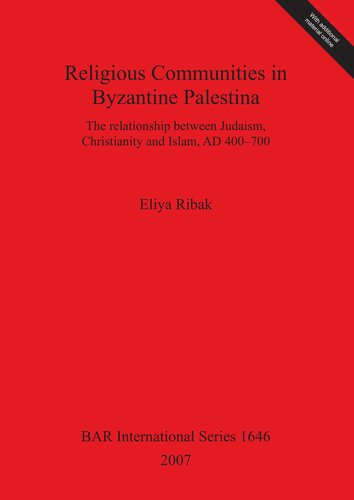

Most ebook files are in PDF format, so you can easily read them using various software such as Foxit Reader or directly on the Google Chrome browser.
Some ebook files are released by publishers in other formats such as .awz, .mobi, .epub, .fb2, etc. You may need to install specific software to read these formats on mobile/PC, such as Calibre.
Please read the tutorial at this link: https://ebookbell.com/faq
We offer FREE conversion to the popular formats you request; however, this may take some time. Therefore, right after payment, please email us, and we will try to provide the service as quickly as possible.
For some exceptional file formats or broken links (if any), please refrain from opening any disputes. Instead, email us first, and we will try to assist within a maximum of 6 hours.
EbookBell Team

0.0
0 reviewsThis study is an archaeological analysis of the relationship between religious communities in Byzantine Palestina (AD 400–700), based on a catalogue of excavated Byzantine sites in the region (forming an appendix to the work). After outlining the historical, archaeological and environmental contexts of the study, the identification and dating of excavated synagogues and churches are re-evaluated. This shows that, although there are clear-cut examples of Jewish and Samaritan synagogues and Christian churches, these buildings are often so similar that it is difficult to differentiate between them. It is also shown that Jewish and Christian burial practices were so similar that, unless accompanied inscriptions or symbols, the religious identity of burials is often difficult to recognize. This suggests that different communities shared similar material cultures of religious practice, probably resulting from peaceful inter-communal interaction, and highlights chronological problems in the archaeology of Byzantine Palestina. Spatial analysis of reliably identified religious buildings is then used to show that different religious communities frequently occupied the same landscapes, and even the same settlements. The credibility of using symbols on portable artefacts to indicate religious identity is assessed, and supported, by examining their association with other religious indicators. Spatial analysis of these artefacts supports the patterns already established, strengthening the interpretation that different religious communities lived in close proximity. This evidence is used to argue for closer and more peaceful co-existence between religious communities in Byzantine Palestina than is usually supposed. It is suggested that this relative religious harmony contributed to the economic prosperity of the region in the Byzantine period. This apparently came to an end in the late sixth or seventh century, when most excavated Byzantine sites in the region were probably disused. Although other explanations (such as plague) are possible, this widespread abandonment may be a consequence of the Persian and/or Muslim invasions. The work concludes with three extensive Appendices of sites, burials, and religious structures.